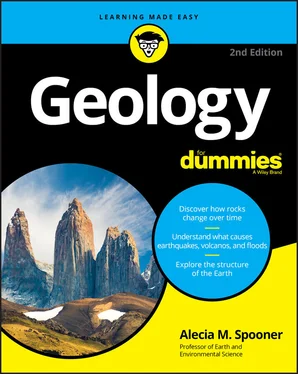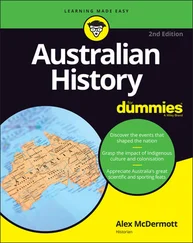Alecia M. Spooner - Geology For Dummies
Здесь есть возможность читать онлайн «Alecia M. Spooner - Geology For Dummies» — ознакомительный отрывок электронной книги совершенно бесплатно, а после прочтения отрывка купить полную версию. В некоторых случаях можно слушать аудио, скачать через торрент в формате fb2 и присутствует краткое содержание. Жанр: unrecognised, на английском языке. Описание произведения, (предисловие) а так же отзывы посетителей доступны на портале библиотеки ЛибКат.
- Название:Geology For Dummies
- Автор:
- Жанр:
- Год:неизвестен
- ISBN:нет данных
- Рейтинг книги:5 / 5. Голосов: 1
-
Избранное:Добавить в избранное
- Отзывы:
-
Ваша оценка:
- 100
- 1
- 2
- 3
- 4
- 5
Geology For Dummies: краткое содержание, описание и аннотация
Предлагаем к чтению аннотацию, описание, краткое содержание или предисловие (зависит от того, что написал сам автор книги «Geology For Dummies»). Если вы не нашли необходимую информацию о книге — напишите в комментариях, мы постараемся отыскать её.
Rock records and geologic time Large-scale motion of tectonic plates Matter, minerals, and rocks The geological processes on earth's surface Rock that geology class with
!
Geology For Dummies — читать онлайн ознакомительный отрывок
Ниже представлен текст книги, разбитый по страницам. Система сохранения места последней прочитанной страницы, позволяет с удобством читать онлайн бесплатно книгу «Geology For Dummies», без необходимости каждый раз заново искать на чём Вы остановились. Поставьте закладку, и сможете в любой момент перейти на страницу, на которой закончили чтение.
Интервал:
Закладка:
Beyond the Book Beyond the Book In addition to what you’re reading right now, this product also comes with a free access-anywhere Cheat Sheet that tells you about plate tectonics and the geologic timescale.. To get this Cheat Sheet, simply go to www.dummies.com and type Geology For Dummies Cheat Sheet in the Search box.
Where to Go from Here Where to Go from Here You have most likely purchased this book with a question about geology already in mind. In that case, I encourage you to follow your interest. Use the table of contents or index to find where I answer your question, flip to that page, and get started! If you don’t have a particular question in mind, here are a few of my favorite topics that will get you started on your study of Earth: Chapter 8 , “Adding Up the Evidence for Plate Tectonics”: In this chapter, I tell you the story of how an early geologist, Alfred Wegener, began to think about plate movements. He collected evidence to support his ideas, but it took many years before the idea of plate tectonics was accepted by the scientific community. This chapter is a great introduction to how science really happens, as well as an overview of the foundational theory of modern geology. Chapter 12 , “Water: Above and Below Ground”: If you want to get started by reading about something you can relate to, start with flowing water. Streams and rivers are the most common geologic processes on Earth. Regardless of where you live, you have probably witnessed the action of flowing water moving sediment or rocks. This chapter provides details from how water picks up and carries particles, to how rivers carve canyons and caves. It also covers the topic of groundwater, which is where most of the water you drink comes from. Chapter 18 , “Time before Time Began: The Precambrian”: Long ago in Earth’s deep, dark, murky past lay the beginnings of life. This chapter describes the first few billion years of Earth’s existence, from its formation from a gaseous cloud, up to and including the earliest evidence for life — in the form of trace fossils called stromatolites.
3 Part 1: Studying the Earth Part 1
Chapter 1: Rocks for Jocks (and Everybody Else) Chapter 1
Finding Your Inner Scientist Finding Your Inner Scientist You are already a scientist. Maybe you didn’t realize this, but just by looking around and asking questions you behave just like a scientist. Sure, scientists call their approach of asking and answering questions the scientific method, but what you do every day is the very same thing, without the fancy name. In Chapter 2 , I present the scientific method in detail. Here, I offer a quick overview of what it entails.
Focusing on Rock Formation and Transformation Focusing on Rock Formation and Transformation As I explore in detail in Part 2 of this book, the foundation of geology is the examination and study of rocks. Rocks are, literally, the building blocks of the earth and its features (such as mountains, valleys, and volcanoes). The materials that make up rocks both inside and on the surface of the earth are constantly shifting from one form to another over long periods of time. This cycle and the processes of rock formation and change can be traced through observable characteristics of rocks found on Earth’s surface today.
Mapping Continental Movements Mapping Continental Movements Most of the rock-forming processes of the rock cycle depend on forces of movement, heat, or burial. For example, building mountains requires force exerted in two directions, pushing rocks upward or folding them together. This type of movement is a result of continental plate movements. The idea that the surface of the earth is separated into different puzzle-like pieces that move around is a relatively new concept in earth sciences, called plate tectonics theory (the subject of Part 3 ).
Moving Rocks around on Earth’s Surface Moving Rocks around on Earth’s Surface On a smaller than global scale, rocks are constantly being moved around on Earth’s surface. Surface processes in geology include changes due to gravity, water, ice, wind, and waves. These forces sculpt Earth’s surface, creating landforms and landscapes in ways that are much easier to observe than the more expansive processes of rock formation and tectonic movement. Surface processes are also the geologic processes humans are more likely to encounter in their daily lives. Gravity: Living on Earth you may take gravity for granted, but it is a powerful force for moving rocks and sediment. Landslides, for example, result when gravity wins over friction and pulls materials downward. The result of gravity’s pull is mass wasting, which I explain in Chapter 11 . Water: The most common surface processes include the movement of rocks and sediment by flowing water in river and stream channels. The water makes its way across Earth’s surface, removing and depositing sediment, reshaping the landscape as it does. The different ways flowing water shapes the land are described in Chapter 12 . Ice: Similar to flowing water but much more powerful, ice moves rocks and can shape the landscape of an entire continent through glacier erosion and deposition. The slow-flowing movement of ice and its effect on the landscape are described in Chapter 13 . Wind: The force of wind is most common in dry regions, and you are probably familiar with the landforms it creates, called dunes. You may not realize that the speed and direction of wind create many different types of dunes, which I describe in Chapter 14 . Waves: Along the coast, water in the form of waves is responsible for shaping shorelines and creating (or destroying) beaches. In Chapter 15 , I describe in detail the various coastal landforms created as waves remove or leave behind sediments.
Interpreting a Long History of Life on Earth Interpreting a Long History of Life on Earth One of the advantages of studying geology is being able to learn what mysteries of the past are hidden in the rocks. Sedimentary rocks, formed layer by layer over long periods of time, tell the story of Earth’s living history: changing climates and environments, as well as the evolution of life from single cells to modern complexity.
Chapter 2: Observing Earth through a Scientific Lens Chapter 2
Realizing That Science Is Not Just for Scientists Realizing That Science Is Not Just for Scientists Science is not a secret society for people who like to wear lab coats and spend hours looking into microscopes. Science is simply the asking and answering of questions. Any time you make a decision by considering what you know, collecting new information, forming an educated guess, and figuring out whether your guess is right, you participate in acts of science. Take a very simple example: choosing a shampoo. You’ve probably tried different types or brands of shampoo, observed how each one leaves your hair looking and feeling, and then decided which shampoo you wanted to purchase the next time. This process of observation, testing, and decision-making is all part of the scientific approach to problem-solving. You follow this process every day in multiple situations as you make decisions about what to buy, what route to take in your car, what to eat for dinner, and so on. Don’t underestimate the role of science in your daily life. Every interaction you participate in — with the physical world and with other people — is governed by the natural laws discovered and described by scientists in multiple fields of specialization. New products and technologies are the result of ongoing answer-seeking in the sciences. And explanations of how human beings effect and are effected by the natural world are constantly being updated by new scientific discoveries. Keep reading to find out how science is done using a step-by-step approach called the scientific method.
Using a Methodical Approach: The Scientific Method Building New Knowledge: A Scientific Theory Speaking in Tongues: Why Geologists Seem to Speak a Separate Language Chapter 3: From Here to Eternity: The Past, Present, and Future of Geologic Thought Catastrophe Strikes Again and Again Early Thoughts on the Origin of Rocks Developing Modern Geologic Understanding Uniformi-what? Understanding the Earth through Uniformitarianism Pulling It All Together: The Theory of Plate Tectonics Forging Ahead into New Frontiers Chapter 4: Home Sweet Home: Planet Earth Earth’s Spheres Examining Earth’s Geosphere
Интервал:
Закладка:
Похожие книги на «Geology For Dummies»
Представляем Вашему вниманию похожие книги на «Geology For Dummies» списком для выбора. Мы отобрали схожую по названию и смыслу литературу в надежде предоставить читателям больше вариантов отыскать новые, интересные, ещё непрочитанные произведения.
Обсуждение, отзывы о книге «Geology For Dummies» и просто собственные мнения читателей. Оставьте ваши комментарии, напишите, что Вы думаете о произведении, его смысле или главных героях. Укажите что конкретно понравилось, а что нет, и почему Вы так считаете.












